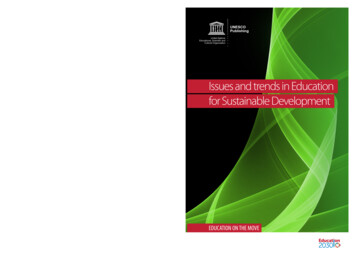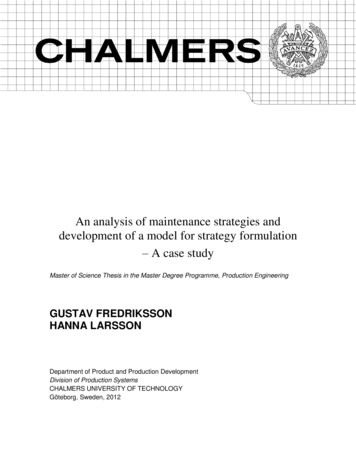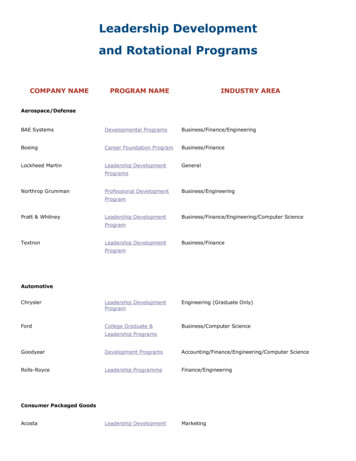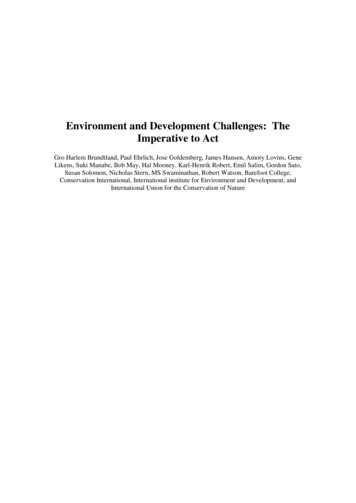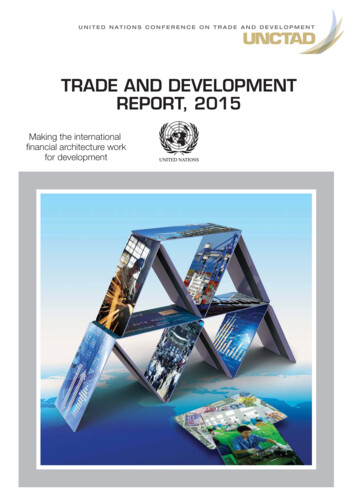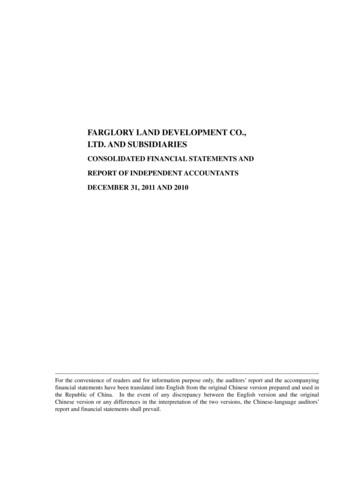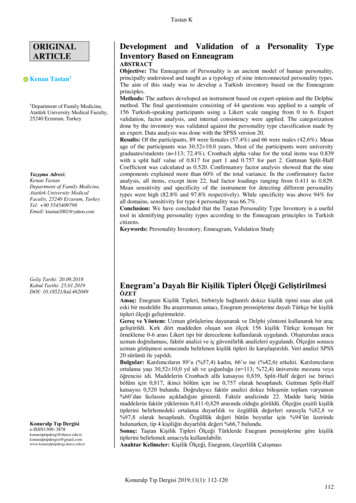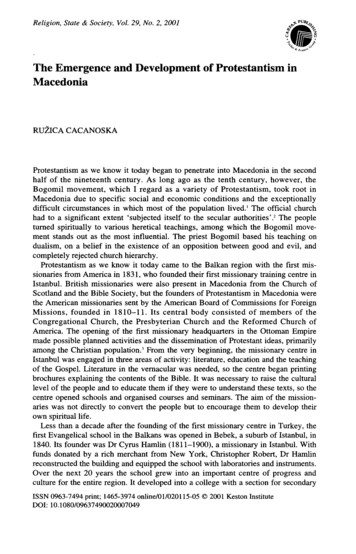
Transcription
Religion, State & Society, Vo/. 29, No. 2, 2001The Emergence and Development of Protestantism inMacedoniaRUZICA CACANOSKAProtestantism as we know it today began to penetrate into Macedonia in the secondhalf of the nineteenth century. As long ago as the tenth century, however, theBogomil movement, which I regard as a variety of Protestantism, took root inMacedonia due to specific social and economic conditions and the exceptionallydifficult circumstances in which most of the population lived.' The official churchhad to a significant extent 'subjected itself to the secular authorities'.2 The peopleturned spiritually to various heretical teachings, among which the Bogomil movement stands out as the most influential. The priest Bogomil based his teaching ondualism, on a belief in the existence of an opposition between good and evil, andcompletely rejected church hierarchy.Protestantism as we know it today came to the Balkan region with the first missionaries from America in 1831, who founded their first missionary training centre inIstanbul. British missionaries were also present in Macedonia from the Church ofScotland and the Bible Society, but the founders of Protestantism in Macedonia werethe American missionaries sent by the American Board of Commissions for ForeignMissions, founded in 1810-11. Its central body consisted of members of theCongregational Church, the Presbyterian Church and the Reformed Church ofAmerica. The opening of the first missionary headquarters in the Ottoman Empiremade possible planned activities and the dissemination of Protestant ideas, primarilyamong the Christian population. 3 From the very beginning, the missionary centre inIstanbul was engaged in three areas of activity: literature, education and the teachingof the Gospel. Literature in the vernacular was needed, so the centre began printingbrochures explaining the contents of the Bible. It was necessary to raise the culturallevel of the people and to educate them if they were to understand these texts, so thecentre opened schools and organised courses and seminars. The aim of the missionaries was not directly to convert the people but to encourage them to develop theirown spiritual life.Less than a decade after the founding of the first missionary centre in Turkey, thefirst Evangelical school in the Balkans was opened in Bebek, a suburb of Istanbul, in1840. Its founder was Dr Cyrus Harnlin (1811-1900), a missionary in Istanbul. Withfunds donated by a rich merchant from New York, Christopher Robert, Dr Harnlinreconstructed the building and equipped the school with laboratories and instruments.Over the next 20 years the school grew into an important centre of progress andculture for the entire region. It developed into a college with a section for secondaryISSN 0963-7494 print; 1465-3974 online/01l020115-05 2001 Keston InstituteDOl: 10.1080109637490020007049
116Ruzica Cacanoskaeducation and a university section and it was managed by a collective presidency,Turkish and American; there was a library and two museums. 4 The staff introducedobligatory missionary work as part of the educational programme. This was carriedout during the summer holidays when the students travelled as missionaries to AsiaMinor, Armenia, Greece, Bulgaria and Macedonia teaching the Gospel and distributing the Bible and brochures with Biblical texts in the respective vernaculars. 5 Theirmissionary work met with a good deal of success.During the 50 years of the college's existence a significant number of youngpeople received college degrees; they later returned to work in their native lands. Thecultural predominance of the college was particularly unwelcome to the Greekpatriarch in Constantinople: he protested to the sultan, who sent him to prison on theallegation that in trying to promote the interests of the Greek church he was workingagainst the interests of the Turkish Empire.For centuries national frames and subframes in Macedonia have created a specificreligious environment that has not been favourable to religious harmony. TheBulgarian, Greek and Serbian churches have struggled to obtain jurisdiction over theChristians in Macedonia. In this tense situation, Protestantism has benefited. 6 Thus,Greek nationalist propaganda in Macedonia has been held to be especially to 'blame'for the emergence and expansion of Protestantism in Strumica. 7'The Balkans have rightfully been described as the powder keg of Europe,' wroteAdventist missionaries in 1980. 'People here are in constant strife. The politiciansshould not be surprised at all if a fire broke out here, whose flames would set thewhole of Europe alight. Now, right now, is the time for the revelation of the Gospelif there is to be peace in the east of Europe.'BAs we have seen, the American Board of Commissions for Foreign Missions wasoriginally based in Istanbul and its intention was to spread gradually into theEuropean regions of the Ottoman Empire: via Bulgaria towards Macedonia, Greeceand Albania. The American Board coordinated its work with that of the MissionarySociety of the Methodist Episcopal Church and reached an agreement with the latteron a regional division of the Balkans. The Board of the Congregational Church,which was the most active member of the American Board, began working in thesouth, while the Methodist Church took the north, beginning in the northernmostparts of Macedonia, in the region of Pirin, spreading further towards the Vardarregion and then moving on to the Aegean region.The American Board began its mission among the Balkan population througheducation by opening schools following western models and standards. In 1860 thefirst Evangelical school for boys in Bulgaria (Muzhkoto nauchno-bogoslovskouchilishte) began its work in Plovdiv. An American school for girls was opened inStara Zagora in 1863. In 1871 the boys' and girls' schools were moved to Samokov,which, partially due to its pleasant climate, became an active 'recruitment' centre,providing training for the staff who later worked mainly in Bulgaria and Macedonia.The missionary training centre was later moved from Samokov to Sofia.The American Board sent a missionary from Sofia, Charles Morse, to work in theRazlog valley. In the course of his previous missionary work Morse had gained areputation as a stout supporter of changes in the educational system and a stem criticof the Orthodox Church. Throwing himself with enthusiasm into his new task,together with his assistant Petur Musevich he soon gained a reputation as an interesting 'foreigner' preaching in Bansko (now in Bulgaria but at that time in Macedonia). Some objected to his 'propaganda', because he was constantly questioningtheir traditional faith and criticising the Orthodox Church. Nevertheless he succeeded
Protestantism in Macedonia117in converting several families and on 6 August 1868 an Evangelical community wasfounded in the village of Bansko, and was officially recognised as a Protestantminority. Thereafter Protestantism slowly gained more adherents in Razlog,Dobrinishte, Eleshnitsa, Yakoruda and Banya.In 1873-74 a missionary training centre was opened in Bitola, one of the economicand cultural centres of Macedonia. From this bridgehead Protestantism was able tospread through the entire region in a planned manner. Local converts provided someof the staff of the training centre, which assigned them to other centres and plannedtheir work; other staff members came from among the foreign missionaries who werenow permanently working in Macedonia. The missionaries in Bitola opened anorphanage and a girls' secondary school in 1890. They also began regular Evangelical services, while the wives of the missionaries set up Bible classes and medicalservices.In 1886 the Bitola training centre established an Evangelical community inRadovis, where the preacher was Nikola BojadZiev, and later in RakliS as well. AnEvangelical church was opened in the village of Monospitovo in 1884, and severalyears later an Evangelical community was established in Murtino. In 1898 the churchin Monospitovo had 60 members, and Kostadin Gracanov became known for hisdedicated work. The first Evangelical church in Kolesino was opened in 1899, andthe first sermon was delivered by pastor Kimov from the church in Strumica, at thehome of Mane Izev, on 19 May 1890. The first Evangelical church building inKolesino was built in 1906 on land donated by Dimitrus Icev. After it was burntdown, another one was built on the site.A missionary training centre in Thessalonica was opened in 1894, under theguidance of Dr John House, who became its administrator. The selection of ThessaIonic a was justified by the fact that it was a centre of economy and communications,and was linked with the hinterland via three main railway lines. This training centrewas very much committed to work with Macedonian prisoners in Beas Kule.An Evangelical community was established in Kukus in 1885 as a result ofnumerous visits by missionaries from Thessalonica and the activity of the evangelicalbooksellers Hristo Zrnev, Dimitar Kardalev and Nikola Trencev. Somewhat later,Evangelical communities were organised north of Kukus, in Gorni and DolniTodorak. In 1896 an Evangelical community was established in Voden, in 1897 inDrama and in 1898 in Enidze Vardarsko.On 23 August 1899 the only conference of Evangelical activists from Macedoniawas held in Thessalonica, under the leadership of John House, Edward Haskell andEllen Stone. In addition to the missionaries, the conference was also attended by anumber of Evangelical activists who had been educated locally in Macedonia.In 1904 Dr House opened a school for agriculture and industry near Thessalonica.This school was attended by children whose parents had died in the IlindenUprising IO The purpose of the school was to promote methods for better treatment ofthe soil through the implementation of contemporary technology. The school was thefirst to bring the tractor to the Balkans. Its programme also included regularEvangelical services.The most sensational event that captured the attention of the world was the abduction of the famous American missionary Ellen Stone. The story of her release wasinternational news. She later proved to be a staunch supporter of the Macedoniancause and a critic of the Turks.11The numerous Evangelical churches and communities established in Macedoniabecame a bulwark for the further dissemination of Protestant ideas, through the
118Ruzica Cacanoskafruitful work of the missionary centres, active oral propaganda and the weaknesses ofthe Orthodox church organisation. In Macedonia Protestantism took deepest root inthe region of Strumica. Located almost at the centre of a triangle formed bySamokov, Bitola and Thessalonica (and also very close to Bansko), Strumica was aunique site where all important lines of communication crossed. Missionary'campaigns', correspondence between the training centres and the missionaries,distribution of Biblical literature and humanitarian activities all constitutedpermanent spiritual mobilisation.In the period that followed, the Balkan Wars (1912-13) and the First World War(1914-18) changed the course of Protestant history in the area. A large number ofEvangelical communities and churches were facing difficulties in their work; someceased to exist, and others moved to other regions. After the First World WarMacedonia was divided into three parts, and so were the Evangelical churches on itsterritory. The American Board of Commissions for Foreign Missions opposed thedivision of the country on the grounds that it would break up the unity of themissionary work in the Balkans. The Protestants from the Pirin part of Macedoniajoined the Evangelical Church in Bulgaria. In the part of Macedonia taken by Greecethe Evangelical Church was annexed to the Greek Presbyterian Church, although itcontinued to work under the name of the Greek Evangelical Church. After ThessaIonic a was ceded to Greece the work of the missionary training centre there began todecline. The same was true of the centre in Korce (now in Albania). The Vardar(north) part of Macedonia became part of Yugoslavia, and the work of the Evangelical Congregational Church was banned there. The church therefore united withthe Methodist Episcopal Church at the latter's Second Annual Conference in Vrbasin May 1922.12 As the Methodist Church of Yugoslavia, it was divided into north andsouth districts, and Macedonia came within the south district. Preacher Pane Ternkovfrom Skopje was elected the supervising priest. Thus dozens of Congregationalchurches in Macedonia became part of, and began working under the name of, theMethodist Church of Yugoslavia.The decline in the number of Protestants became obvious at the beginning of 1912.The churches in Kavadarci and Dojran closed down. Some Protestants emigrated toAmerica. After the Vardar part of Macedonia was ceded to Serbia in 1913, the rate ofdecline became ever more apparent. The influence of the Bitola missionary trainingcentre was significantly reduced and that of the missionary training centres inThessalonica and Korce could now hardly be felt at all.The decline in interest in Protestant ideas is also connected with developmentswithin the churches themselves, marked by a growing influence of more liberalcurrents. Liberal interpretations of the Bible, based on contemporary scholarlyresearch, encountered strong resistance on the part of the traditionally-orientated andconservative missionary circles that had already taken root in the Balkan region.Several years before the outbreak of the Second World War, in 1934, theAmerican Board withdrew its missionary staff from the Balkans: with its living heartremoved, Protestant activity continued to decline. The period between the two WorldWars was also marked by an overt policy to diminish Macedonian self-awarenessand influence, which made the work of the churches and missionaries significantlymore difficult.During the Second World War conditions rendered the spiritual work of theProtestant churches and missionaries almost impossible. After the War the Germanpopulation left Yugoslavia and the Methodist Church of Yugoslavia (in Vojvodina)suffered a significant fall in numbers. And now communism appeared on the scene,
Protestantism in Macedonia119hostile to all religion. Macedonia became an atheist republic and all denominationslost adherents. Since the end of communism the number of Protestants in Macedoniahas risen again. They are located in various parts of the country, most strongly inStrumica. With the dissolution of the Socialist Federal Republic of YugoslaviaProtestant church organisation in Macedonia underwent certain changes. TheProtestant communities in Macedonia had previously been linked with those in otherparts of Yugoslavia, but the independence of the Republic of Macedonia has imposedthe need for independently organised Protestant communities and their direct linkagewith world associations.Notes and References10II12'Protestantism' has been defined as comprising all those Christians who accept thefollowing principles as part of their religious affiliation: 'a. The Bible is the sole source ofrevelation; b. the study and the interpretation of the Bible is based on personal judgment;c. religious rites are reduced to the necessary minimum; d. all that is understood asreligious life is communicated in the vernacular.' Aleksandar Birvis, 'Plodovi protestantizma', Kultura (Belgrade), nos. 13-14, 1971, pp. 124-37.Slavko Dimevski, /storijata na makedonskata pravoslavna crkva (Makedonska kniga,Skopje, 1989), p. 69.The missionaries decided to work with the Christian population because Turks whorenounced Islam were punished by death.Hristo Andonov Polyanski, The Attitude of the US towards Macedonia (MacedonianReview Editions, Skopje, 1983), p. 34.Paula Mojzes, Metodizam: kratka istorija metodisticKe crkve (Sekretarijat Metodistickihcrkava FNRJ, Novi Sad, 1962), p. 69.It is interesting that Eastern-Rite Catholicism was once a significant phenomenon inMacedonia. Very much like Protestantism, it is free from specific Balkan national identification. See Slavko Dimevski, Makedonskata borba za crkovna i nacionalna samostojnost vo XIX-ot vek (Unijatskoto dvizhenje) (Nasa Kniga, Skopje, 1988).Manol Pandevski and Dj. Stoev-Trnkata, Strumica i strumicKo niz istorijata (Strumica,1969), p. 188.Glasnik hriscanske adventistiCke crkve, no. 4, Belgrade, 1980, p. 18.Mane Izev played an important role in the development of the Evangelical Church inStrumica. Together with Trajko Kovacev, he was a psalm reader in the Orthodox church inthe village; the liturgy was celebrated in Greek. Having come across the Bible, he read itvery attentively, and often studied it with his friends. At that time, Dimitar Kardalev wasselling Biblical literature in the village, and he spent the night at Izev's house. He gaveIzev a copy of the Bible and two other books. Izev began to preach in Macedonianbecause, as he explained, very few people understood Greek, and they were neither Greeksnor Bulgarians. Izev and his followers came under pressure from the authorities, who weresuspicious of their work, but this did not divert them from their course.The Ilinden Uprising began on St Elijah's Day, 2 August 1903. Some 30,000 rose in armsagainst the Turks. The rebellion was finally put down in October; thousands were killed ortaken prisoner and over 200 villages were burnt.In 1894 a secret revolutionary organisation was founded to fight for Macedonian autonomyin the Turkish Empire. Its practice was to capture people and hold them to ransom. InSeptember 1901 it seized the American missionary Ellen Stone and her escort KatherineTsilka. They were released the following February for 14,500 golden Turkish lire. SeeManol Pandevski, lane Sandanski i Mis Ston (Misla, Skopje, 1992).Gligor Cekov, 110 godini od evangelskoto delo vo selo Kolesino (Evangelsko-metodistickata crkva Kolesino, Kolesino, 1990), p. 6.
Istanbul. British missionaries were also present in Macedonia from the Church of Scotland and the Bible Society, but the founders of Protestantism in Macedonia were the American missionaries sent by the American Board of Co

